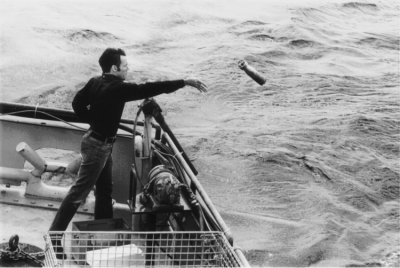Explosive Sound Sources
Explosive Sound Sources
Description

A 0.82-kg (1.8-lb) SUS (Signal, Underwater Sound) explosive charge being launched by Dr. Peter Worcester from the R/V Oceanus in 1979 for underwater acoustic research.
Underwater explosions generate high-intensity impulsive signals that may be used for research. Some devices are specifically designed to be explosive sound sources . Signals generated by explosions can propagate over hundreds or even thousands of kilometers. Some explosive sources provide high power at low frequencies for studying seafloor structure and in oil and gas exploration.
One of the most commonly used underwater explosive sound sources is the 0.82-kg (1.8-lb) SUS (Signal, Underwater Sound) explosive charge. A typical SUS charge contains the chemical compound TNT. A chemical explosion generates a shock wave and an oscillating gas bubble . The bubble oscillation creates a series of progressively weaker pressure pulses called bubble pulses.
For more details on explosive sound sources, please visit the Technology Gallery.
References
- Chapman, N. R. (1985). Measurement of the waveform parameters of shallow explosive charges. The Journal of the Acoustical Society of America, 78(2), 672–681. https://doi.org/10.1121/1.392436
- Chapman, N. R. (1988). Source levels of shallow explosive charges. The Journal of the Acoustical Society of America, 84(2), 697–702. https://doi.org/10.1121/1.396849
- Kedrinskii, V. K. (2007). Underwater Explosive Sound Sources. In M. J. Crocker (Ed.), Encyclopedia of Acoustics (pp. 539–547). Hoboken, NJ, USA: John Wiley & Sons, Inc. https://doi.org/10.1002/9780470172513.ch47